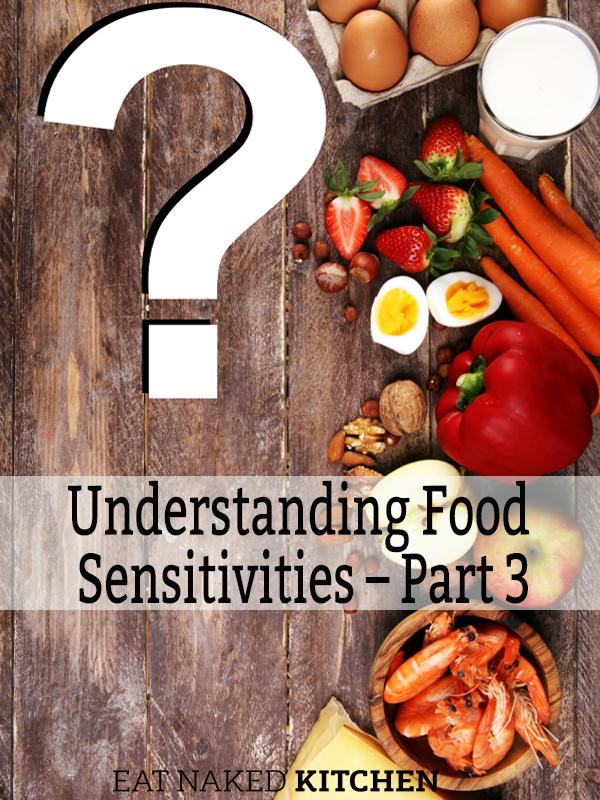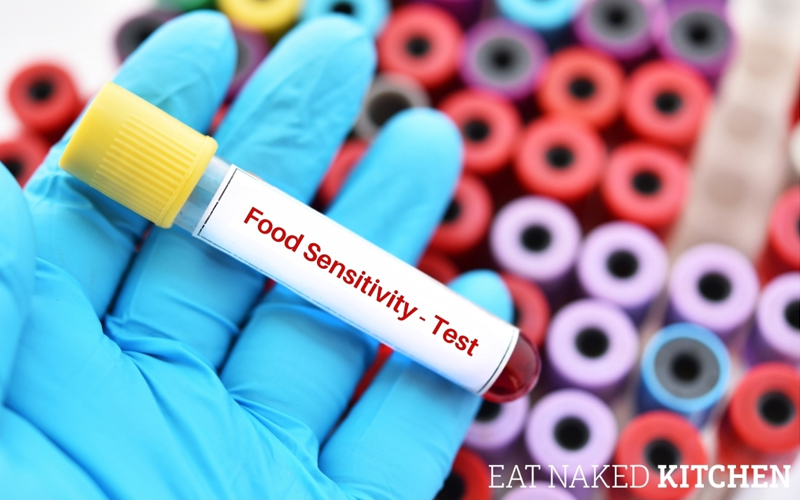In part 1 of this series, we looked at what food sensitivities actually are, and how they’re different from food allergies and food intolerances. In part 2, we looked at what symptoms can indicate whether food sensitivities are present, how our bodies can have an adverse reaction to something as innocuous as food, and how food sensitivities develop over time.
If you’re just jumping in at this point, I highly recommend you take a minute or two to go and read through parts 1 and 2 so that we’re all working from the same understanding and framework.
This week, I want to talk about how to determine specifically what foods, if any, are causing adverse reactions in your body. In part 2, I gave you a list of symptoms and health concerns that have been linked to food sensitivities. Having one or more of these symptoms doesn’t mean you necessarily have food sensitivities, but it warrants further investigation. And of course, it’s vitally important that you find out exactly what foods you’re sensitive to so that you can temporarily eliminate them from your diet and begin the healing process.
Unfortunately, testing for food sensitivities isn’t black and white. This is one of the reasons it is controversial in the health community. There are many different testing options, and not all are created equal. You see, there are lots of complicating factors:
- For one, as I explained in Part 1, there are many different mechanisms for driving an adverse response to food: some immune-mediated, some cell-mediated. Most testing processes look at one or two specific mechanisms, which means they necessarily aren’t getting the whole picture.
- The question of whether you are sensitive to a particular food doesn’t have a yes/no answer. You can be mildly sensitive to one food, and more severely sensitive to another food. These reactions occur on a spectrum and thus we’re talking about many different shades of gray.
- To further complicate things, it can take up to 3 days for an adverse reaction to manifest in your body. That’s a long time! And presumably, you’ll have eaten many other foods in the interim. This makes it very challenging to track without formal testing. Some basic approaches like food journaling can be insightful, but very difficult to identify exact patterns because there are so many possibilities.
- And lastly, food sensitivities compound on each other. You may have mild reactions to several foods that you eat in the same meal, and thus provoke a more serious reaction than you would if you were to eat these foods in isolation or without other triggering foods. Since we don’t typically eat just one food at a time, this is a major complicating factor.
Crazy making? Pretty much.
So let’s look at the different ways of testing for food sensitivities:

1) Elimination diet
An elimination diet is much like what it sounds: you temporarily eliminate potentially offending foods for a period of time to clear them from your system (usually 10-14 days minimum). Then you slowly re-introduce these foods on a specific schedule (usually one food introduced every 3 days to account for delayed reactions) watching carefully for adverse reactions.
Now this way of testing can be a great starting point, and indeed we’ve structured our Real Food Reboot to include the basics of this kind of elimination diet, but it’s not conclusive. The key challenge is in the definition of “potentially offending foods.” Most elimination diets, including ours, just eliminate the most common culprits: gluten, dairy, soy, and/or eggs. But what if you’re sensitive to avocado? Or lettuce? Or tomatoes? Or any other food or chemical for that matter? As you can see, it becomes impractical in a hurry to eliminate everything from your diet. To slowly introduce all foods, one every three days, would require a discipline that is difficult to fathom. Furthermore, it doesn’t solve the problems of combined foods and degrees of sensitivity.
2) Cocoa’s pulse test
This is another DIY test that I described in detail here. I like this test because it can help you tune into your body for an overt physiological response: a speeding pulse. BUT, not all sensitivities drive up the pulse and it doesn’t address the fact that sometimes you can eat combinations of foods that are mild sensitivities. This is another good starting point, but not conclusive.
3) Mechanism-specific tests
As I described in Part 1, there are many different mechanisms in your body for initiating an adverse reaction to a specific food. Some are immune-mediated, some are cell-mediated. A mechanism-specific test is looking for a specific mechanism to be triggered by the ingestion of a food: usually we’re talking about IgA, IgG, IgE, or IgM type responses. The most common of these are the ELISA and RAST tests, and these are the most popular ways to test for sensitivities.
Now, these tests can be quite accurate for testing one or two specific mechanisms, but what about the mechanisms they are NOT testing for (of which there are many)? Conversely, this is one of the reasons why food allergies – or type 1 hypersensitivities as I explained in Part 1 – are so easy to identify: we’re only looking for one mechanism, the release of IgE. Unfortunately, when it comes to the more complex category of food sensitivities, these tests don’t give us the full picture.
4) Mediator-measuring tests
The last type of test takes the middle man out of the picture. Instead of measuring the mechanism for initiating an adverse reaction to a food, it goes straight to the end result: the release of mediators such as histamines, cytokines and prostaglandins. You see, these guys are responsible for actually causing inflammation in the body. While there are multiple different pathways (or mechanisms) for triggering the release of these mediators, what’s actually important when it comes to determining whether a food causes an adverse reaction or not is whether these mediators are released on exposure to that food. Mediator-measuring tests look for this response, and thus eliminate one of the critical complicating factors of food sensitivity testing overall.
There are three companies that do this type of testing: the ALCAT, the LRA by ELISA/ACT, and the MRT (Mediator Release Test) by Oxford Biomedical. My preferred test by far – and in my opinion the gold standard in the world of food sensitivity testing – is the MRT. Here’s why I love it so much:
- The MRT tests a wide variety and long list of foods – not just the most common sensitivities. It tests 150 different foods and chemicals – it’s not every food you could possibly eat, but it’s a darned good representation.
- The MRT recognizes that there are certain chemicals found in some foods either naturally or added through food processing that can trigger adverse reactions. They test for these in addition to the foods, which can provide very helpful information about whole categories of food. A good example of this is solanine, the chemical in nightshades (potatoes, eggplant, peppers, tomatoes) that some people are sensitive to. You’ll hear broad recommendations of “oh, don’t eat nightshades – they’re really inflammatory” but that’s not the case for everyone. Testing for a solanine sensitivity will be helpful to know whether nightshades are truly an issue for you or not.
- The MRT accounts for shades of gray and shows the degree of sensitivity for each food. This is really helpful when coming up with a diet protocol that addresses these sensitivities.
- It is over 90% accurate, which is almost unheard of in the world of food sensitivity testing.
- It is based on physiological principles that are broadly supported in the scientific literature and by published studies.
- And, perhaps most importantly, in my practice I have seen the best results when working with the results of this particular test.
Now, the MRT isn’t flawless. It’s not 100% accurate, which of course would be ideal but doesn’t exist at this point. Further, it won’t identify IgE food allergies (type 1 hypersensitivities), because that response doesn’t occur in the blood. But most people know the true food allergies they have – what’s more complex and difficult to pinpoint are the food sensitivities, the type 3 and 4 hypersensitivities that don’t involve an IgE immune reaction.
A side note about skin testing:
Another test used to identify adverse reactions to food is skin testing – this often known as the “scratch test” and is the test most commonly used by medical professionals. In this type of test, the skin is irritated with the specific antigen (beef, egg, and so on). If there is an allergy, then the immune cells will release histamine, which will appear as a red inflamed area on the skin, much like a mosquito bite.
I haven’t included skin testing in my list of options above because it’s only useful for identifying true food allergies – those type 1 hypersensitivities we described in Part 1 – and is utterly useless for food sensitivities. Many people go to their doctor, have this test done, and believe that it is conclusive for all adverse reactions to food, so I want to clear up that confusion. Of note: while it’s the most commonly used test and the gold standard for airborne allergies (pollens, dander, and so on), this test isn’t all that accurate for food allergies either.
So, now that we know what foods we’re sensitive to, we just eliminate them for a while and all is good, right? Not so fast… I wish it were that simple but that’s one of the challenges of working with food sensitivities. It’s a lot more complex than just eliminating the trigger foods.
In the next and final installment of this series, we’ll look at exactly how to go about removing them from the diet while also healing the gut so that you can then reintegrate these foods safely in the future.




Margaret,
Love your blog and love this series!! I’m afraid I’ll need a part 5, though! I’ve been tested for food sensitivities and done an elimination diet, slowly added things back in, reestablished a working diet with those items that were “safe” for me and my un-inflamed gut… And now it’s been five years and two kids later. Can new sensitivities develop? What about the old food sensitivities; are they always forever going to be on my do-not-eat list? With every child I’ve had, my ‘symptoms’ seem to dwindle or change forms in an uncategorizAble pattern. To determine if I still have (the same) sensitivities, would I have to go through the whole testing process again? Thanks for your insight!
Hi Elaine – I’m posting part 4 tomorrow and I think it will be very insightful for you. In short: YES new sensitivities can and do develop unless you’ve done the proper healing work.
You mention Type 1,3 and 4 but nothing on Type 2. What is type 2?
Great catch, Sara! Type two hypersensitivities are not food-related – that’s why I didn’t include them.